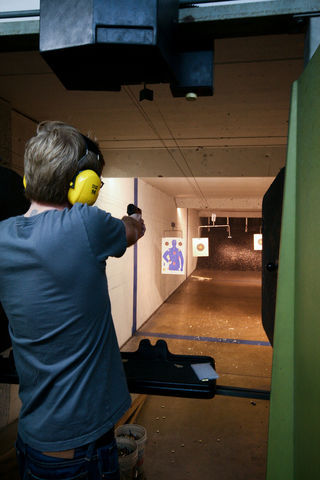
There is a neglected question in the gun debates. It is, however, of vast importance: How do guns shape us? That is, what is their impact on our hearts, minds, and souls? And do they have any impact on our character?
To answer these questions, we need to look at something called Gun Culture 2.0.1 For most of the 20th century, the focus of gun owners was on hunting and shooting for sport as a recreational pursuit. Receiving a rifle became a rite of passage for many young boys. Hunting, target shooting, and collecting guns are still important aspects of gun culture in the United States. However, according to David Yamane, there has been a shift from these to a focus on guns as a means of self-defense, a shift from what is called Gun Culture 1.0 to Gun Culture 2.0. The focus of Gun Culture 1.0 is recreation. The main focus of Gun Culture 2.0 is armed citizenship. The majority of gun owners now cite self-defense as their primary reason for owning a gun.
To the extent that the Gun Culture 2.0 instills in people a willingness to kill, it can be harmful to their character.2 My claim is not that owning and using a gun necessarily compromises character. But if one does so, and adopts much of what Gun Culture 2.0 involves, it can have a negative impact. Let’s look at why.
First, a vast majority of us have a deep psychological resistance to killing other people. This is obviously a good feature of human nature. It is grounded in human empathy that recognizes others, including our enemies, as human beings. How we think about, value, and use guns may prevent us from fully appreciating these truths.
One way that this can occur is by dehumanizing our enemies. This dehumanization can then overcome our natural resistance to killing another human being. In military contexts, this can occur in a couple of ways. First, it can be done by conditioning a person to fire a gun at another human being without really thinking about the action that is being performed. This could occur by training soldiers to fire at human-like targets and providing rewards or punishments based on success in such exercises. The hoped-for result is that soldiers will develop quick-shoot reflexes, not thinking about the fact that they are killing another human being at the moment of the conditioned response. This is a sad necessity of war. Many later feel revulsion at what they have done or struggle with it in other ways.
This is relevant to Gun Culture 2.0, insofar as a big part of that culture involves firing at human-shaped targets. For example, in one account of a "rolling thunder" shotgun drill, a line of shooters stand 10 yards away from steel plates, shaped like human silhouettes.3 The point is to practice reloads and manipulations so that the shooter is prepared for a home invasion. In order to do this, the first shooter at the one end of the line waits for a timer. When it goes off, she emergency loads a shell and fires. After she fires, the next shooter does the same, and so on down the line. Then, the first shooter tube loads a shell and emergency loads another, firing twice. The next round, each shooter tube feeds two shells, emergency reloads one and fires three. Next, each tube feeds three, emergency reloads one and fires four. In this exercise, rewards and punishments are present, depending on how successful each individual shooter is:
Rolling Thunder is a great way to hone your shotgun skills. It adds a unique stress because not only are you competing against yourself, you’re working as a team to move as quickly and accurately as possible. If even one shooter fumbles his reloads and/or botches his shots the entire line suffers as the final time for the drill rises. Bonus points if you hone your dual, triple, or quad loads during the drill.
Another example of a rolling thunder drill involves a line of shooters with handguns, about 10 yards or so from paper human silhouette targets. It is nighttime. A person with a flashlight shines a light on the first target, and once his target is lit the shooter immediately fires. This is repeated down the line. These types of competitions and other forms of shooting practice involve creating a quick-shot reflex, which can weaken the natural resistance to killing another human being.
There is another way that the resistance to killing can be thwarted. When we are encouraged to see others, be they military enemies or other members of our own society, as morally inferior, they are dehumanized and thereby easier to kill. This can be done through racist epithets, as was the case in Vietnam and Iraq. It can also be done by seeing the enemy as evil, as morally inferior and deserving of death. Some in the gun rights movement refer to criminals as “wolves” and themselves as “sheepdogs” protecting the “sheep.” The wolves are the bad guys; the sheepdogs are the good guys protecting the innocent but defenseless sheep.
But how, in particular, can this harm character? If our resistance to killing others is weakened by conditioning or seeing them as morally inferior, empathy for them is weakened. Many psychological studies show that empathy is connected to altruistic acts and to acts involving helping others. It also plays a role in preventing aggression and violence.
In short, empathy is important for good character. Weakening empathy by dehumanizing others in these ways harms our character. It makes it more difficult to have virtues that are deeply connected with empathy. Compassion, sympathy, and kindness come to mind. If we see others as less than human, this can lead to moral vices, including callousness, cruelty, and malice.
Does this mean that killing another in self-defense or war is never justified, grounded in concerns about character? No. Nor does it mean that soldiers or others who engage in these actions have bad character. Such an act may be morally justified, but it is nevertheless tragic. The morally virtuous person who, as a last resort, kills an assailant in self-defense (or in defense of another person) may not be guilty of a morally unjust act. Nevertheless, if that person has good character, is empathetic, compassionate, and loving, she “will feel regret at having been the agent of killing.”4
The loss of life, even if necessary to protect other life, will be a source of pain and regret.
What are we to make of all of this? Guns may not damage the character of their owners. But if we use them in the ways much of Gun Culture 2.0 encourages, we risk harming our character in serious ways.
References
1. See David Yamane, “The Sociology of U.S. Gun Culture,” Sociology Compass 11, no. 7 (July 1, 2017): e12497, https://doi.org/10.1111/soc4.12497. “Gun Culture 1.0 and 2.0” are terms coined by Michael Bane, a journalist and author. For more info, see his blog http://michaelbane.blogspot.com
2. What follows draws from a discussion of military training, but the parallells with Gun Culture 2.0 are made clear. See Franco Trivigno, “A Virtue Ethical Case for Pacifism,” in Virtues in Action: New Essays in Applied Virtue Ethics, ed. Michael W. Austin (New York: Palgrave Macmillan, 2013), 86–101.
3. “I Call Shotgun: The Rolling Thunder Drill,” The Truth About Guns, August 12, 2018, https://www.thetruthaboutguns.com/2018/08/kat-ainsworth/i-call-shotgun-….
4. Trivigno, “A Virtue Ethical Case for Pacifism,” p. 93.




